404 Not Found
Our apologies. The Office of Research and Economic Development website has moved.
Please proceed to our new website at https://olemiss.edu/ored/.

Our apologies. The Office of Research and Economic Development website has moved.
Please proceed to our new website at https://olemiss.edu/ored/.